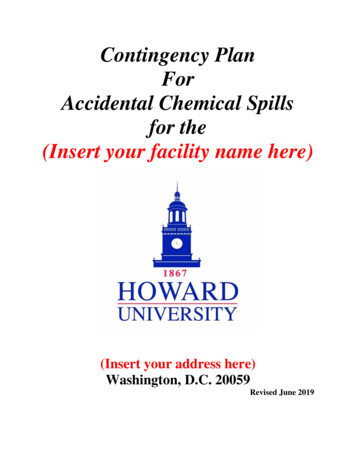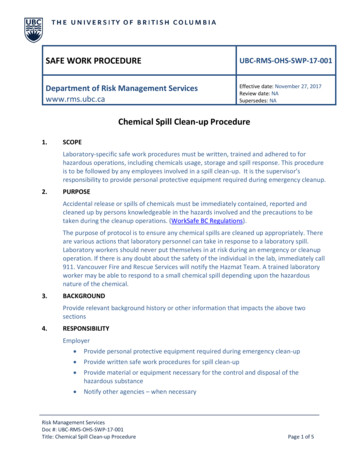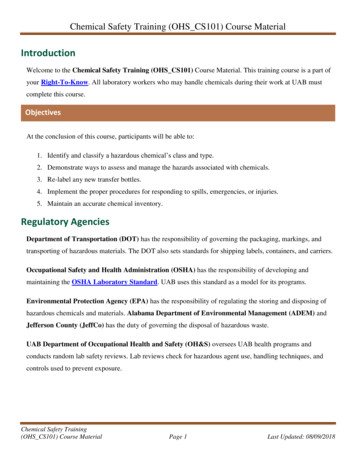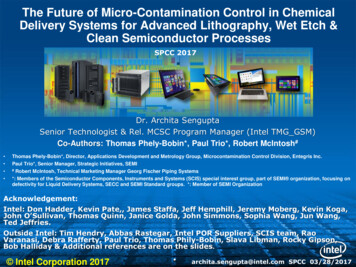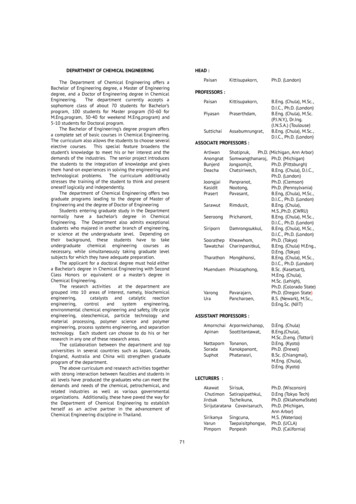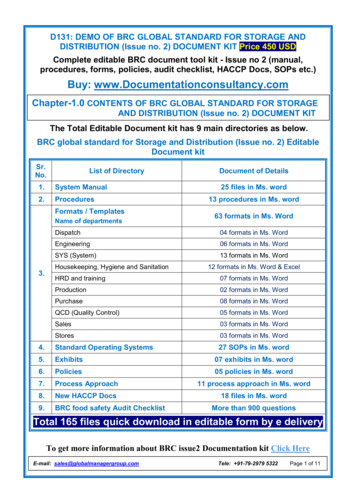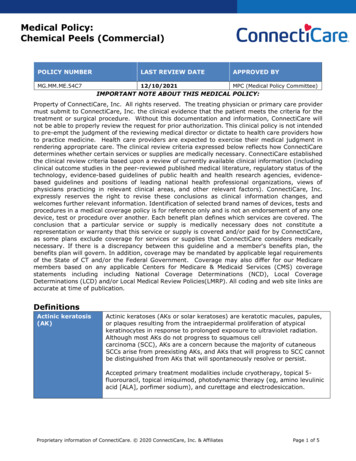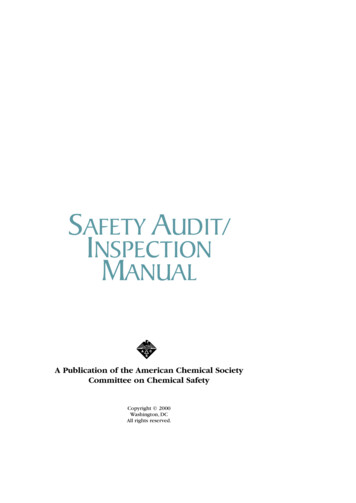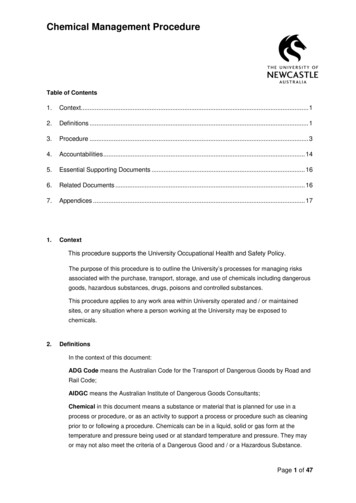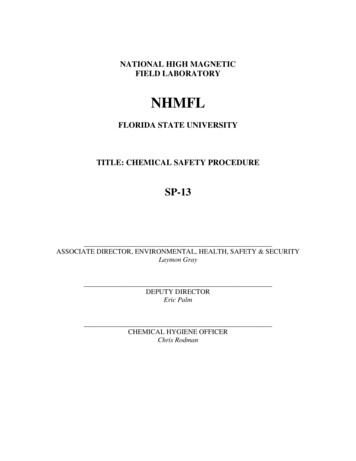
Transcription
NATIONAL HIGH MAGNETICFIELD LABORATORYNHMFLFLORIDA STATE UNIVERSITYTITLE: CHEMICAL SAFETY PROCEDURESP-13ASSOCIATE DIRECTOR, ENVIRONMENTAL, HEALTH, SAFETY & SECURITYLaymon GrayDEPUTY DIRECTOREric PalmCHEMICAL HYGIENE OFFICERChris Rodman
NATIONAL HIGH MAGNETIC FIELD LABORATORYCHEMICAL SAFETY PROCEDURE: SP-13FLORIDA STATE UNIVERSITY1.0PURPOSEThe purpose of this procedure is to establish policy and procedure to be observed by all labpersonnel at the National High Magnetic Field Laboratory including all employees, users,visitors, contractors, or other persons when handling hazardous chemicals and materials.The Occupational Safety and Health Administration (OSHA) have legal authority in mattersconcerning employee safety. In most cases, employees are protected by OSHA's General IndustryStandards (29 CFR 1910). One of the primary standards is the Hazard Communication Standard(29 CFR 1910.1200) which requires employers to disclose toxic and hazardous substances inworkplaces and provide appropriate training needed to understand health and safety risks.Since the National High Magnetic Field Laboratory at Florida State University (Maglab) employsworkers engaged in the use of hazardous chemicals and materials, the Maglab is required tocomply with the provisions of another OSHA standard: 29 CFR 1910.1450 Occupational Exposureto Hazardous Chemicals in Laboratories. This standard is commonly referred to as "The OSHALab Standard." It was developed to provide increased protection to Maglab employees above thatprovided in the General Industry Standard.Understanding the moral and legal obligation to provide for the safety of Maglab employees is thefirst step in complying with the OSHA Lab Standard. The backbone of the OSHA Lab Standard isits requirement for the Maglab to develop and carry out the provisions of a written ChemicalHygiene Plan (CHP). The Maglab’s required Chemical Hygiene Plan is found in Chapter 5.0 ofthis safety procedure (SP-13).The CHP OSHA requirements are outlined in APPENDIX B.
2.0SCOPEThis document applies to all personnel working with hazardous chemicals and materials that areunder the control of the Maglab. It is to be used as part of the overall Maglab Safety Program.This procedure is to be used by all personnel at the NHMFL, including employees, and contractors.This procedure identifies the specific requirements for the management, use and disposal ofhazardous chemicals and materials. This procedure also establishes responsibilities as applicablefor the administration and implementation of the Chemical Hygiene Plan (CHP).3.0POLICYThe policy of the NHMFL is to provide and maintain a safe and healthful working environmentthat insures everyone at the Maglab are protected against exposure to hazardous materialspossessing the potential to harm people, property, or the environment. Employees and labpersonnel alike shall assist in ensuring safety is not compromised. The safety and health ofemployees and personnel are the inherent responsibilities of each employee, user, management,and all levels of supervision.4.0INTEGRATED SAFETY MANAGEMENT (ISM)All Maglab employees, users and contractors that work with hazardous chemicals or materialsmust assess the risk hazard of their processes before work can proceed.Residual risk categories after all controls are in place define how the work will proceed:A. Low: proceed using ISMB. Low Medium: proceed with caution using ISM. A second worker is in the vicinity.C. Medium: Seek guidance from Safety Department before proceeding. Two authorizedworkers must be in place before work can proceed. Limited number of authorized workers asmaintained by the Safety Department.D. Medium High: Seek guidance from Safety Department before proceeding. Twoauthorized workers must be in place before work can proceed. Limited number of authorizedworkers as maintained by the Safety Department. Work can only proceed if authorized by theDirector or his designee.E. High: Work will not be performed.Refer to APPENDIX A for ISM risk assessment.
5.0CHEMICAL HYGIENE PLAN (CHP)CHP Index:5.1.0Standard Operating Procedures: Handling Toxic .1.95.1.105.1.115.1.125.2.0Control Measures: Reducing Chemical Exposure5.2.15.2.25.2.35.3.0Engineering ControlsPersonal Protective EquipmentSafety EquipmentFume Hood Performance5.3.15.3.25.3.35.4.0Chemical PurchasesChemical StorageChemical LabelingTransportation of Hazardous Chemicals and MaterialsWorking with Organic SolventsWorking with Flammable LiquidsWorking with Corrosive ChemicalsWorking with Compressed and Liquefied GasesWorking with Cryogenic MaterialsWorking with NanomaterialsChemical Emergencies, Exposures and SpillsHazardous WasteYearly CertificationsInspections by UsersContingency Plan for Hood FailuresEmployee Information and Training5.4.1 General Training5.4.2 Safety Data Sheets5.4.3 Lab Safety Hazwaste Training5.4.4 Hazard Communication Training5.5.0Requirements for Prior Approval of Maglab Activities5.6.0Medical Consultation and Exams5.7.0Chemical Hygiene Responsibilities
5.8.0Special Precautions for Work with Particularly Hazardous Substances5.8.15.8.25.8.35.8.45.8.5Working with Particularly Hazardous Chemicals and MaterialsWorking with Highly Reactive ChemicalsWorking with Chemicals of High Acute Toxicity, including CarcinogensWorking with Chemicals that are Reproductive HazardsWorking with Hydrofluoric Acid5.1.0STANDARD OPERATING PROCEDURES: HANDLING TOXIC CHEMICALS5.1.1Chemical PurchasesEstimate the amount of chemical required for each experiment or project and order only what isnecessary. Older stocks should be used first. Excess chemicals are very expensive to dispose ofand can create a hazard if stored too long.Understand the hazards associated with each chemical and plan appropriate protective measures.Safety Data Sheets can be found at FSU Safety Data Sheet Online Database, through yourchemical vendor, or consult other resources. Contact your supervisor or the NHMFL SafetyDepartment for information about safe handling and disposal of your chemicals.Plan experiments with safety in mind. Substitute less hazardous chemicals in procedures wheneverpossible. Utilize green chemical alternatives whenever possible. A useful reference is the MITGreen Chemical Alternatives Purchasing Wizard that contains over 200 journal references andcase studies to provide useful alternatives for some of the most common hazardous solvents andsubstances found at the Maglab. Remember to purchase minimal amounts of chlorinated solvents.Minimize the use of mercury and replace mercury-containing devices with non-mercury optionswhenever possible.When your order arrives, inspect the packaging carefully for any signs of breakage or leakage ofcontents. If there are any signs of leakage, place package in a safe location, such as in animpervious and compatible secondary container within a chemical fume hood, protect personnelfrom exposure, and call the NHMFL Safety Department for assistance.
5.1.2Chemical StorageThe following are general requirements for chemical storage at the Maglab; contact the NHMFLSafety Department at safety@magnet.fsu.edu for specific guidance.Chemicals should be stored based on compatibility with other chemicals in the storage unit;compatible chemicals can be stored alphabetically. Acids, flammable liquids, oxidizers and highlyreactive chemicals should all be separated and stored properly to avoid an unwanted chemicalreaction.Go here for an Incompatible Chemical Storage Guide. This list should be used only as a guide.Consult the MSDS for specific incompatibilities.Acids should be stored in nonmetal corrosives cabinets, separated from flammable andcombustible material, bases, active metals (sodium, potassium, magnesium), or chemicals thatcould generate toxic gases upon contact, such as silver cyanide, iron sulfide, etc. Incompatibleacids may be stored in separate cabinets or by placing in separate secondary containers;information about incompatible acids can be found on the FSU Corrosive Storage Guidelines site.Bottle carriers should be used during transport of acids.Bases should be stored in a separate corrosives cabinet from acids, and stored away from metals,explosives, organic peroxides and easily ignitable materials. Inorganic hydroxide solutions shouldbe stored in polyethylene containers.Flammable Liquids in volumes of 10 gallons (37.8 liters) or more should be stored in flammablescabinets. Flammables should be stored away from sources of ignition, and segregated fromoxidizing acids and oxidizers. Fire extinguishers must be available. Standard refrigerators are notsuitable for flammables storage because the electrical components may produce a spark. However,flammable chemicals may be stored in refrigerators designed for this storage in accordance withNFPA 45 Refrigeration. Contact the NHMFL Safety Department for information.Reactive chemicals should be stored appropriately, away from other reactants. Chemicals thatreact with water should be sealed and kept in a container with absorbent material. Secondarycontainment should be labeled.Long term storage of peroxide forming chemicals creates a hazardous situation for lab workersand the NHMFL safety staff, and may result in high waste disposal costs for highly unstablechemicals. Always use or dispose of these chemicals on or before the expiration date on the label.Toxic compounds and carcinogens should be stored according the hazardous nature of thechemical, using appropriate security. Researchers must contact the NHMFL Safety Departmentbefore purchasing highly toxic gases.Pyrophoric chemicals should be stored in a cool, dry place with an airtight seal. Researchers mustcontact the NHMFL Safety Department before purchasing pyrophoric gases.
Always label chemicals in English with the exact contents, if appropriate include date of receipt,and, expiration date.Storage areas should be properly ventilated and should be adequately designed and constructed.Large containers of reagents should be stored on low shelving, preferably in trays to contain allleaks and spills. Chemicals should not be stored on the floor, on bench tops, and only minimallyinside fume hoods if required for some toxic compounds.The quantity of chemicals that are stored should be reduced to an absolute minimum.5.1.3Chemical LabelingAll original containers must be labeled with the chemical constituents and hazard. Labels onoriginal containers must not be removed or defaced until disposal. It is recommended that allchemicals are dated when received, but dating is crucial for compounds which have a specifiedshelf life, such as those that will form peroxides (e.g. ethyl ether). Failure to label chemicals andwaste greatly increases disposal costs. All Maglab personnel who are leaving the University areresponsible for identifying and properly disposing of the chemical waste prior to their departure.The OSHA Lab Standard requires that commercially labeled hazardous chemicals must identify: The identity of the material.Known immediate and delayed hazards.Manufacturer or suppliers contact informationPrecautionary hazard warnings.
NFPA LabelingNFPA 704 labels indicate chemical hazards within a laboratory building or chemical storage area,and are often included on chemical labels or the Safety Data Sheets (SDS). The NFPA diamondsummarizes the hazards within a posted area, and is used primarily to alert emergency responsepersonnel to acute chemical hazards that are present. The NFPA diamond indicates:Health –the following applies for chemicals present in small amounts:4 – fatality likely3 – permanent injury2 – serious injury1 – minor injury0 – injury unlikelyFlammability4 - Vaporizes completely at normal Pressure & Temperature, also it burns readily3 – Can be ignited under almost all ambient conditions2 – Ignition requires moderate to high heating1 – Ignition requires substantial preheating0 – Not combustibleReactivity- at standard Temperature & Pressure4 - Explosive detonation, decomposition or reaction3 – explosive reaction requires heat or water initiation2 – readily violent decomposition or reaction w/water but no detonation1 – normally stable unless elevated heat, pressure H20 reaction potential0 – normally stable, not H 2 0 reactiveWhite – refers to a specific hazard.
ANSI LabelingAmerican National Standard Institute (ANSI) has published a voluntary labeling standard (ANSIZ129.1-1988) followed by most chemical manufacturers that includes: Signal words - DANGER, WARNING, CAUTION (highly toxic materials shall bemarked POISON).Precautionary measures useful in preventing physical harm to the individual.Instructions in case of exposure.Notes to physician for emergency treatment.Instructions in case of fire or chemical spill.Instructions for chemical handling and storage.Example of an ANSI compliant chemical labelA.B.C.D.E.F.G.H.Product Name and DescriptionProduct NumberFurther Descriptive InformationRecommendations on Handling and Storage: Storage temperatures indicated are for longterm storage of products. Products may be shipped under different conditions to reduceshipping costs, while still ensuring product quality.Hazard StatementIndication of dangerLot AnalysisData on activity, purity, degree of hydration, etc., for this lot.
I. Package Size: Unless the material is described as pre-weighed, the package will normallycontain at least the indicated quantity, and usually somewhat more. For some products,the actual quantity at time of packaging is also shown. The user should always measurethe amount needed from the container.J. Lot NumberK. Hazard Pictogram – see Chemical Hazard Pictograms below: Lets you know at a glancewhat safety hazards are involved in the use of this product.L. Further Hazard Information: More complete description of actual hazards, handlingprecautions, and emergency management procedures.M. CAS Number: Chemical Abstract Service number shown wherever available. CASnumbers vary in how specifically they define the material. We make every effort toprovide the most specific CAS number which applies. Where a CAS number is providedfor a mixture or solution, it is usually the CAS number of the solute or componentreferred to in the main label name.N. Chemical Formula and Formula Weight: Unless water of hydration is indicated in theformula, the formula weight is for the anhydrous material.O. Risk and Safety Statements: Information is provided in multiple languages.P. Safety Data Sheet Available: A Safety Data Sheet is available for this product.Q. EC Number: EC Number (EINECS or ELINCS), products without an EINECS numberwill carry the warning statement, "Caution: Substance Not Yet Fully Tested.
Chemical Hazard Pictograms
5.1.4Transportation of ChemicalsPersonnel who move hazardous chemicals and materials from one campus location to another needto be aware that chemicals and other hazardous materials should only be handled or transportedby trained personnel who are familiar with the specific hazards and safety precautions associatedwith the particular products. For large amounts of chemicals or for transport of acutely toxicchemicals, personnel must always work in teams.Use the following guidance when transporting chemicals or any hazardous material on Universityproperty: Contact the NHMFL Safety Department in advance of the move.Be ready for emergencies -- if there is a spill that has the potential to endanger humanhealth, immediate call 911 and take appropriate steps to ensure the safety of those in theimmediate area.If a spill has the potential to impact storm drains, take immediate action to protect the stormdrain (dirt dike).In the event of a spill, notify a supervisor and the NHMFL Safety Department at 855SAFEMAG regardless of the perceived extent of the spill.Move hazardous chemicals and materials during regular working hours.Only trained Maglab personnel may move chemicals and other hazardous materials.Commercial movers or departmental staff can move lab supplies but NOT hazardousmaterials.Do not attempt to move outdated ethers or other potentially unstable/reactive compoundsChemicals that are outdated and potentially unstable; in corroded containers; havingcracked or missing lids; are unknown or unlabeled should not be moved.Do not move chemical waste.Use proper protective equipment as appropriate.Where possible, heavy or bulky quantities of hazardous materials should be transported byelevator, preferably one reserved exclusively for freight.Personnel should not ride in elevators with bulky quantities of hazardous materials.Pack hazardous chemicals (solvents, corrosives, toxic chemicals) and all liquids withcompatible chemicals.Make sure that all chemicals are securely capped.Place in a secondary container like a tub or bin that could adequately contain the entirecontents if the primary container failed. Contact the NHMFL Safety Department for binsfor moves between Innovation Park and FSU campuses.Individual chemical containers not in original packaging must be placed in a secondaryplastic container when transporting.Do not place incompatible chemicals together in the same bin.Glass bottles containing hazardous chemicals should be packed in vermiculite or otherabsorbent materials and have sufficient cushioning.Relatively non-hazardous dry chemicals may be packed in boxes.DO NOT MOVE hazardous chemicals or materials in personal vehicles .Hazardous chemicals and materials must not be left unattended or stored in corridors,departmental offices, or other non-Maglab locations.
If chemicals are to be shipped off-site, contact the NHMFL Safety Department at 644-0233or 644-6955 for guidance on packaging and shipping regulations.Transporting materials with specific hazards 5.1.5Compressed gas cylinders should only be transported with the protective cap in place andon approved carts.Cylinders must always be secured to these carts using chains or straps.Cryogens - Personnel should never occupy an elevator being used for the transportation ofcryogens; a release of cryogenic material will displace oxygen and can create anasphyxiating environment – 1L of liquid N 2 , if completely sublimated where there is no airexchange, will displace 700L of air.This type of transport should be accomplished by securing the material in the elevator,exiting the elevator and connect safety chain with “NEVER ride in elevators withcompressed gas cylinders or dewars” sign attached.Solvents – Special consideration should be made of the potential for an accident whentransporting solvents as these may be highly toxic and have other hazardous properties.Corrosives – Concentrated acids are usually transported in rubber protective sleeves.It is unsafe to carry concentrated acids for long distances, even if protected by rubbersleeves, without a cart and secondary containment (tub).Reactive, old or potentially unstable chemicals - Do not attempt to move outdated ethersor other potentially unstable/reactive compounds.Working with Organic SolventsA solvent is a liquid that dissolves a solid, liquid, or gaseous solute resulting in a solution. Theterm organic solvent refers to most other solvents that are organic compounds and contain carbonatoms. In addition to the handling of solvents for flammable, corrosive or other properties; toxicityand carcinogenicity must be considered when working with organic solvents. Solvents usuallyhave a low boiling point and evaporate easily or can be removed by distillation, thereby leavingthe dissolved substance behind. Solvents are usually clear and colorless liquids and most of themhave a characteristic smell.Most organic solvents are combustible, often highly volatile and extremely flammable and theyshould always be handled with care. Some solvents produce vapors, which are heavier than air.These may move on the floor or ground to a distant ignition source, such as a spark from weldingor caused by static electricity. Vapors of solvents can accumulate in confined places and stay therefor a long time, presenting risks for health and property. The NHMFL Safety Departmentrecommends that solvents be used in a fume hood for these reasons.
Solvents enter the body by inhalation, by swallowing and through the skin. The effect depends onseveral factors, such as: How easily the solvent evaporates at the ambient temperature.The characteristics of that solvent; is it water soluble or able to dissolve fats.The concentration of the solvent in the air at the place of work.The type of work is involved, i.e. light or heavy.How long the exposure lasts.Solvents, including their vapors and mists, have various effects on human health. Solvents irritatethe eyes and the respiratory tract and many of them have a narcotic effect, causing fatigue,dizziness and intoxication. High doses may lead to unconsciousness and death. Work with solventsshould be done within a fume hood for these reasons.Solvents may damage the skin by removing the fat. This is a very common cause of skin disordersand dermatitis. Some solvents penetrate the skin and enter the blood circulation. Solvents maydamage the liver, kidneys, heart, blood vessels, bone marrow and the nervous system. Certainsolvents, such as benzene, are carcinogens.Personal Protective Equipment for Organic Solvent HandlingIf gloves, goggles, or other protective clothing are needed to keep solvents away from skin, eyes,and clothing, make sure gloves are made of material that is not permeable to the solvents you areusing. Personal protective equipment such as aprons, gloves and eye protection equipment shouldbe stored in a clean place away from possible contact with solvent vapors. Workers must knowsafe work methods and emergency procedures (fire, spill, first aid) for the specific chemicals theyuse.Many organic solvents are flammable. Refer to flammable liquids for more information.Equipment (fire extinguishers, absorbent material, etc.) should be provided for situations such asspillage or emergency.Solvent ContainersEach vessel containing chemical stocks or solutions should have a label showing the chemical. Ifchemicals must be transferred from the original containers, the new containers should be labeledwith the chemical name. Containers are closed or covered when not in use. Compatible containersmust be used. Transfer of solvents between containers may require grounding to prevent dischargeof static electricity.Solvent DisposalThe NHMFL Safety Department will provide containers to dispose of solvents on request. Onceyou have received a container, and filled it, simply contact us at safety@magnet.fsu.edu and wewill take them to our waste facility and return your waste receptacle.
5.1.6Working with Flammable LiquidsFire hazards are associated with vapors from the flammable liquid. In order for a fire to occur, thefollowing conditions must be met: Concentration of the vapor must be between the upper and lower explosion limit (SeeTable below)An oxidizing material must be presentSource of ignition must be presentFlammability Characteristics of Some Common SolventsFlammable Limits (%)ChemicalFlashpoint ( C) Lower % Upper .11.37.1Carbon Disulfide-301.350Cyclohexane-201.38Diethyl Ether-451.936Ethyl Acetate-4211.5Ethylene mine-113.646Gasoline (approximate) thyl Acetate-103.116Methyl Ethyl Ketone -6.11.810Pentane-401.57.8Toluene4.41.27.1CRC Handbook of Lab Safety, 5th Edition, page 265.Working safely with flammable liquids Order only the amounts that are necessary.Remove all nearby sources of ignition.Heat flammable liquids with safe heating equipment (e.g. mantles) or explosion safeequipment.
When transferring flammable liquids using metal containers, ground both containers.Store flammable liquids in safety cans, flammable storage cabinets or flammable storagerefrigerators.Do not leave solvent distillation processes unattended.Storage of Flammable LiquidsLimits for the storage of flammable solvents are based on fire hazards associated with each liquid.The following requirements must be followed: Flammable liquids stored at the laboratory should be kept to a minimum.Flammable liquids should not be stored next to incompatible chemicals.Storage of flammable liquids outside approved flammable storage cabinets and safety cansmust not exceed 10 gallons per 100 square feet of laboratory space, including waste (Seethe NFPA tables below for details).If you have flammable storage cabinets and approved safety cans, total storage must notexceed 20 gallons per 100 square feet of laboratory space (See the NFPA tables (4) and (5)below for details).There are maximum container size requirements for different classes of flammable liquids andlimits for the maximum amounts stored, as indicated in the tables below. Consult the NHMFLSafety Department for more information.Is it flammable or combustible what NFPA classification applies?To understand OSHA requirements for the safe storage of flammable and combustible liquids, wemust begin by defining the two. A flammable liquid is any liquid having a flashpoint below 100 F (37.8 C) (except any mixture having components with flashpoints of 100 F (37.8 C) or higher,the total of which make up 99 percent or more of the mixture)(1910.106(a)(19)).Flammable liquids are categorized into three groups, as follows:Class IA - Liquids having flashpoints below 73 F (22.8 C) and having boiling pointsbelow 100 F (37.8 C) (1910.106(a)(19)(i)). Examples: Acetaldehyde, ethyl ether andcyclohexane.Class IB - Liquids having flashpoints below 73 F (22.8 C) and having boiling points ator above 100 F (37.8 C) (1910.106(a)(19)(ii)). Examples: Acetone, benzene and toluene.Class IC - Liquids having flashpoints at or above 73 F (22.8 C) and below 100 F(37.8 C) (1910.106(a)(19)(iii)). Examples: Hydrazine, styrene and turpentine.A combustible liquid is any liquid having a flashpoint at or above 100 F (37.8 C)(1910.106(a)(18)). Combustible liquids are divided into two classes:
Class II - Liquids having flashpoints at or above 100 F (37.8 C) and below 140 F (60 C), except any mixture having components with flashpoints of 200 F (93.3 C) or higher,the volume of which make up 99 percent or more of the total volume of the mixture(1910.106(a)(18)(i)). Examples: Acetic acid, naphtha and stoddard solvent.Class III - Liquids having flashpoints at or above 140 F (60 C) (1910.106(a)(18)(ii)).Class III liquids are subdivided into two subclasses:Class IIIA - Liquids having flashpoints at or above 140 F (60 C) and below 200 F,except any mixture having components with flashpoints of 200 F (93.3 C) orhigher, the total volume of which make up 99 percent or more of the total volumeof the mixture (1910.106(a)(18)(ii)(a)). Examples: Cyclohexanol, formic acid andnitrobenzene.o Class IIIB - Liquids having flashpoints at or above 200 F (93.3 C)(1910.106(a)(18)(ii)(b)). Examples: Formalin and picric acid.oThe flashpoint and boiling point determine the class of a liquid. However, these should not be theonly criteria used to determine the hazards of a liquid. Many other factors should also beconsidered for the proper use and storage of hazardous liquids. These factors include: ignitionstemperature, explosive limits (LEL or UEL), vapor pressure, specific gravity and vapor density.Table 1: Flash point/Boiling points for NFPA CategoriesFlash PointFahrenheit CelsiusTYPEClass IA 73 22.8Class IB 73 22.8Class IC73 - 100 22.8 - 37.8Class II100 - 140 37.8 - 60Class IIIA 140 - 200 60 - 93.3Class IIIB 200 93.3Boiling PointFahrenheit Celsius 100 37.8 100 37.8
Table 2: Maximum Quantities of Flammable and Combustible Liquids and LiquefiedFlammable Gases in Sprinklered Lab Units Outside of Inside Liquid Storage AreasLab UnitFire HazardClassA (High)B(Moderate)C (Low)D(Minimum)FlammableandCombustibleLiquid ClassII, II and IIIAII, II and IIIAII, II and IIIAII, II and IIIAMaximumQuantity per9.3 m2 (100ft2) of LabUnitMaximumQuantityper LabUnitMaximumQuantity per9.3 m2 (100ft2) of LabUnitMaximumQuantityper LabUnitExcluding Quantities inIncluding Quantities inStorage Cabinets or Safety Storage Cabinets or SafetyCansCansLGalLgalLgalLgal38102270 6007620 4540 120076203028 800 15040 6060 16002051136 3003810 2270 60038101515 4007620 3028 8007.52570 1501541136 300154757 2003081515 40041.1284757.52570 15041.1284757.52570 150
Table 3: Maximum Quantities of Flammable and Combustible Liquids and LiquefiedFlammable Gases in Nonsprinklered Lab Units Outside of Inside Liquid Storage Areas*Lab UnitFire HazardClassFlammableandCombustibleLiquid ClassIA (High)I, II and IIIAIB(Moderate)C (Low)D(Minimum)I, II and IIIAII, II and IIIAII, II and IIIAMaximumMaximumQuantity per Quantity9.3 m2 (100per Labft2) of labUnitUnitExcluding Quantities inStorage Cabinets or SafetyCansLgalLgalNot permittedNotpermittedNotNot permittedpermittedNot permittedNotpermittedNotNot permittedpermitted7.5228475154380 10041.11403741.114037MaximumMaximumQuantity per Quantity9.3 m2 (100 per lab Unitft2) of LabUnitIncluding Quantities inStorage Cabinets or SafetyCansLgalLGalNot permittedNotpermittedNotNot permittedpermittedNot permittedNotpermittedNotNot permittedpermitted154570 150308760 2007.52284757.5228475
Table 4: Maximum Quantity Permitted Excluding Storage Cabinet and Safety CansLab unit firehazard classFlammable orcombustible liquidclassA (High)1 I, II and IIIAB (Moderate)1 I, II and IIIAC (Low)1 I, II and IIIAD (Minimum)1 I, II and IIIAExcluding Quantities in Storage Cabinets orSafety CansMaximumMaximum quantity per Labquantity per 100unitsq. ft. ofLab unitWithoutWithsprinklerssprinklers10 gallons 20300 gallons600 gallonsgallons400 gallons800 gallons5 gallons 10150 gallons300 gallonsgallons200 gallons400 gallons75 gallons 100 150 gallons2 gallons 4 gallonsgallons200 gallons1.1 gallons 1.137 gallons 37 75 gallons 75gall
NFPA 704 labels indicate chemical hazards within a laboratory building or chemical storage area, and are often included on chemical labels or the Safety Data Sheets(SDS ). The NFPA diamond summarizes the hazards within a posted area, and is used primarily to alert emergency response personnel to acute chemical hazards that are present.

